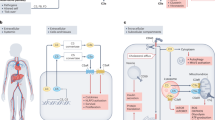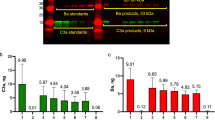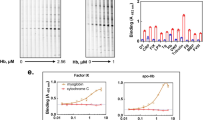Abstract
THERE is now much evidence that the classical complement pathway can be activated by substances other than immune complexes. Leonard and Thorne1 found that precipitate formed between the polyanion, polyglutamic acid, and lysozyme was anticomplementary, although the site of action was not determined. Since then, many polyionic substances and complexes have been found to activate the classical complement pathway, namely polyinosinic acid2, dextran sulphate2,3, cellulose sulphate4, heparin–protamine complexes5, lipid A6, lysozyme–DNA complexes7, doublestranded DNA8 and C-reactive protein–polycation complexes9. Although activation by heparin–protamine complexes was found to take place in agammaglobulinaemic serum10, it is possible that the polyions do not react directly with C1, but that they bring about aggregation of IgG, which then combines with and activates C1. On the other hand, C-reactive protein attached to the surface of red cells can activate complement without involvement of antibody or IgG (refs 11, 12), as can certain oncaviruses13 and mitochondrial membranes14. It has also been shown that the complement component C1q will combine with glutaraldehyde-treated red cells and that the binding sites involved on the C1q molecule are probably those also involved in binding to immune complexes15. It has now been found that glutaraldehyde-treated red cells not only bind to C1q, but can also activate the complement system through the classical pathway, with no evidence of involvement of immunoglobulin.
This is a preview of subscription content, access via your institution
Access options
Subscribe to this journal
Receive 51 print issues and online access
$199.00 per year
only $3.90 per issue
Buy this article
- Purchase on Springer Link
- Instant access to full article PDF
Prices may be subject to local taxes which are calculated during checkout
Similar content being viewed by others
References
Leonard, C. G. & Thorne, C. B. J. Immun. 87, 175–188 (1961).
Yachnin, S. & Ruttenberg, J. M. J. clin. Invest. 44, 518–534 (1965).
Loos, M. & Bitter-Seurmann, D. Immunology 31, 931–934 (1976).
Eisen, V. & Loveday, C. Br. J. Pharmac. 39, 831–833 (1970).
Rent, R., Ertel, N., Eisenstein, R. & Gewurz, H. J. Immun. 114, 120–124 (1975).
Lachman, P. J. & Nicol, P. in Advances in Biosciences 12, (ed. G. Raspe) (Pergamon, Oxford, 1974).
Willoughby, W. F., Ford, R. T. & Shin, H. S. J. Immun. 111, 296–297 (1973).
Cooper, N. R. in Contemporary Topics in Molecular Immunology 2 (ed. R. A. Reisfeld & W. J. Mandy) (Plenum, New York, London, 1973).
Siegel, J., Osmand, .AP., Wilson, M. F. & Gewurz, H. J. exp. Med. 142, 709–719 (1975).
Fiedel, B. A., Rent, R., Myhrman, R. & Gewurz, H. Immunology 30, 161–169 (1976).
Kaplan, M. H. & Volanakis, J. E. J. Immun. 112, 2135–2147 (1974).
Osmand, A. P., Mortenson, R. F., Siegl, J. & Gewurz, H. J. exp. Med. 142, 1065–1076 (1975).
Cooper, N. R., Jensen, F. C., Welsh, R. M. & Oldstone, M. B. A. J. exp. Med. 144, 970–984 (1976).
Pinckard, R. N. et al. J. Immun. 110, 1376–1382 (1973).
Hughes-Jones, N. C. Immunology 32, 191–198 (1977).
Lachman, P. J., Hobart, M. J. & Aston, W. P. in Handbook of Experimental Immunology (ed. D. M. Weir) (Blackwell, Oxford 1973).
Chaplin, H., Freedman, J. & Hughes-Jones, N. C. Immunology 32, 1007–1015 (1977).
Laurell, C. B. Analyt. Biochem. 10, 358–361 (1965).
Romano, E. L. & Mollison, P. L. Br. J. Haemat. 29, 121–127 (1975).
Verhoef, J., Peterson, P. K., Kim, Y., Sabath, L. D. & Quie, P. G. Immunology 33, 191–197 (1977).
Author information
Authors and Affiliations
Rights and permissions
About this article
Cite this article
HUGHES-JONES, N., GARDNER, B. & ROWLANDS, J. Activation of human complement by glutaraldehyde-treated red cells. Nature 270, 613–614 (1977). https://doi.org/10.1038/270613a0
Received:
Accepted:
Issue Date:
DOI: https://doi.org/10.1038/270613a0
Comments
By submitting a comment you agree to abide by our Terms and Community Guidelines. If you find something abusive or that does not comply with our terms or guidelines please flag it as inappropriate.



